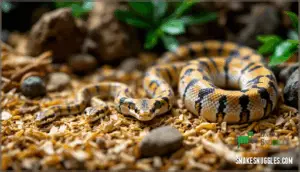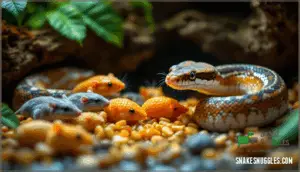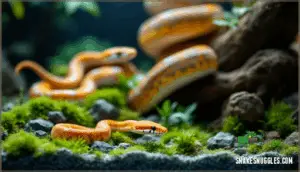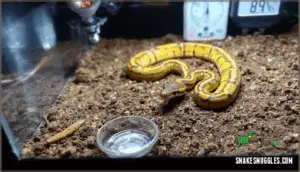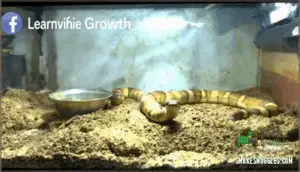This site is supported by our readers. We may earn a commission, at no cost to you, if you purchase through links.

Most corn snakes reach their adult length of 3.5–5 feet by age three, though some keep adding inches until year four. Genetics set the ceiling, but feeding schedules, temperature zones, and prey quality determine whether your snake hits its potential or plateaus early.
Tracking monthly measurements reveals whether your husbandry practices support healthy development or if adjustments are needed.
Table Of Contents
- Key Takeaways
- How Fast Do Corn Snakes Grow?
- Corn Snake Growth Factors
- Growth Rate Variability
- Feeding Strategies for Growth
- Monitoring Growth Progress
- Potential Growth Issues
- Frequently Asked Questions (FAQs)
- How big do corn snakes grow?
- Do corn snakes grow faster?
- When do corn snakes become adults?
- Do corn snakes grow faster male or female?
- When do corn snakes stop growing?
- How do corn snakes grow?
- Why is my 2 year old corn snake so small?
- How to make a corn snake grow faster?
- How long does it take for a corn snake to be full grown?
- How big are corn snakes at 1 year old?
- Conclusion
Key Takeaways
- Corn snakes grow from 8–12 inches at hatching to 2–3 feet by their first birthday, then reach their full adult size of 3.5–5 feet between ages two and three, with genetics setting the ultimate length ceiling while feeding frequency, temperature gradients, and prey quality determine whether they hit that potential.
- Feeding juveniles appropriately sized prey (1–1.5× body width) every 5–7 days accelerates growth by 20–25% compared to less frequent schedules, while adults need feeding only every 10–14 days to maintain weight without obesity—overfeeding creates unhealthy fat accumulation rather than faster development.
- Monthly measurements of both length and weight provide the data you need to catch growth problems early, with red flags including less than 5–10 cm monthly growth in year one, regurgitation after consecutive feedings, or visible lethargy that signals parasites, temperature issues, or nutritional deficiencies requiring veterinary attention.
- Proper temperature gradients (75–82°F cool side, 80–85°F basking spot) directly control digestion speed and metabolism, while calcium and vitamin supplementation every 4–8 feedings prevents metabolic bone disease—environmental factors you control matter as much as genetics in determining whether your snake reaches its full size.
How Fast Do Corn Snakes Grow?
How quickly can you expect your corn snake to grow? Hatchlings start at 8–12 inches long, and during their early development, corn snakes generally add 12 to 18 inches per year. By their first birthday, most juveniles reach 2–3 feet.
Growth rate depends on genetics, diet quality, and environmental conditions. You’ll notice females often outpace males in weight and length, sometimes exceeding them by 20% once mature.
Most corn snakes hit their adult size—between 3 and 6 feet—around 2 to 3 years old, though growth slows considerably after sexual maturity. Corn snakes are non-venomous snakes popular as pets.
Corn Snake Growth Factors
Your corn snake’s growth doesn’t happen in a vacuum—it’s shaped by several interconnected factors that work together to determine how quickly they’ll reach their full size. Understanding these key influences helps you create the best conditions for steady, healthy development.
Let’s look at the three main factors that affect your corn snake’s growth rate.
Genetics and Growth Potential
Your corn snake’s final size isn’t just about care—it’s written in its DNA. Genetic factors set the blueprint for adult length, 3–5.5 feet, and weight around 1.5–2.5 pounds. Morph growth rates vary slightly, with snow morphs growing slowest among tested varieties. Breeding for size through selective pairing can influence offspring dimensions, though most color mutations don’t dramatically affect growth rate. Heritability of size means larger parents often produce bigger offspring under similar conditions. Corn snakes are known for their striking coloration, exhibiting vibrant orange, red, and black blotched patterns. Learn more about corn snake patterns.
- Genomic growth control involves over 15,000 genes working together, not single mutations
- Genetic diversity across regional populations creates natural size variation you’ll observe
- Selective breeding for size has reduced wild variation, making captive growth more predictable
- Some morphs correlate with slightly stunted growth due to pigmentation gene effects
- Fast-developing genotypes reach breeding size by 24–30 months versus 36 for slower lines
Diet and Nutrition
What you feed directly shapes how fast your corn snake grows. Whole-prey diets—mice and rats—deliver the protein (55–60%) and fat (20–25%) needed for steady development. Prey composition matters: rodents provide calcium, vitamin A, and vitamin D₃ naturally. A well-balanced diet with nutritional quality matched to size promotes best growth without shortcuts.
Hatchlings fed every 5–7 days usually grow from 10–15 g to 80–100 g in six months. Feeding frequency drives growth efficiency, but overfeeding adds unhealthy fat. Hydration helps digestion, so keep fresh water available.
Health and Husbandry Practices
Your enclosure setup directly impacts growth rate. Proper corn snake temperature—75–82°F cool side, 80–85°F warm side—keeps metabolism steady. Enclosure hygiene through weekly cleaning cuts illness risk. Stress reduction means two hides, limited interaction, and quiet surroundings. Lighting needs include 12-hour cycles for natural rhythms. Hydration practices with clean water support digestion. Veterinary checkups catch problems early, preventing inadequate diet, stress, or illness from stunting growth.
- Temperature zones let your snake choose what feels right for digestion
- Weekly substrate changes stop parasites before they take root
- Dual hideouts give your snake control over its comfort
- Calm interaction times build trust without triggering stress responses
- Fresh water access makes sure every meal processes smoothly
Growth Rate Variability
Not every corn snake grows at the same pace, and that’s perfectly normal. Several key factors work together to influence how quickly your snake reaches adult size.
Let’s look at what drives these differences and what you can control to support healthy development.
Individual Growth Rates
You might wonder why two corn snakes from the same clutch can end up vastly different sizes. Growth variation is normal—genetics plays a huge role in determining how fast your snake gains length and weight. Studies show that genetic factors account for around 35–45% of adult size potential, meaning some individuals are simply hardwired to grow faster or slower.
Genetics alone determines 35–45% of your corn snake’s adult size—some are simply hardwired to grow faster or slower than their clutchmates
Sexual dimorphism also matters: females generally grow 10–15% larger than males under the same care conditions. Even morph influence can affect development, with certain linebred color patterns growing up to 20% slower than wild-type snakes.
Tracking your snake’s measurements monthly helps you understand its unique growth rate and spot any concerns early.
Crucial Factors for Healthy Growth
Beyond genetics, you need to nail several factors affecting corn snake growth to keep your snake thriving. Temperature gradients of 26–33°C and humidity regulation around 65–75% directly influence metabolism and digestion. Nutritional consistency—feeding juveniles every 5–7 days with appropriately sized prey—fuels steady development. Stress reduction through hiding spots and minimal interaction prevents feeding interruptions that stall growth.
Even with ideal corn snake habitat requirements, genetic traits set the ceiling: some morphs naturally reach 137–180 cm, while others max out 25% smaller. Promoting healthy corn snake growth means balancing corn snake diet and nutrition with proper corn snake temperature and humidity.
Feeding Strategies for Growth
Your corn snake’s growth depends largely on what you feed, how often you feed, and the variety you provide. Getting the feeding strategy right helps your snake reach its full size while staying healthy.
Let’s look at the key factors that influence growth through diet.
Feeding Frequency Impact
Your feeding schedule acts like a growth dial—turn it one way, and your snake thrives; turn it too far, and problems emerge. Juveniles fed every 5–7 days grow 20–25% faster than those fed every 10+ days, reaching adult size 6–8 months earlier. This frequency boosts metabolic efficiency and aids shed cycles every 20–28 days instead of 35–40.
Adults need feeding every 10–14 days to maintain weight without obesity. Balanced feeding frequency directly impacts longevity, behavioral outcomes, and prey digestion efficiency throughout your corn snake’s life.
Prey Size Considerations
Think of prey size like Goldilocks—not too big, not too small, just right. Preferred prey should measure 1–1.5× your snake’s body width to prevent regurgitation risks and support steady growth stages.
Here’s your prey assessment guide:
- Hatchlings (8–20 inches): pinky mice weighing 0.5–3 g
- Juveniles (20–45 inches): fuzzies and hoppers at 3–8 g
- Adults (>35 inches): adult mice at 15–25 g
- Weight calibration: prey equals roughly 10% of body mass
- Safety rule: never exceed 1.5× body width
Match prey size to your snake’s current measurements using feeding guidelines, adjusting your feeding schedule as they grow. This approach prevents digestive strain while maximizing nutrient absorption.
Diet Variety and Supplementation
Your corn snake’s diet is more than just mice—it’s a nutritional toolkit. While whole prey provides essential proteins and fats, frozen rodents may lack vitamin D and other micronutrients found in wild-caught food. Rotate prey types like chicks or quail every few feedings to mimic natural dietary rotation and prevent deficiencies.
Dust prey with calcium and multivitamin powder every 4–8 feedings—about monthly—to support skeletal growth without risking toxicity. UVB benefits include enhanced calcium absorption, though proper supplementation can maintain health without it.
Follow careful thawing practices: never refreeze or microwave prey, as this destroys nutrients and creates contamination risks. Match your feeding guidelines for proper growth to your snake’s life stage, adjusting supplement schedules as body condition and shed quality indicate. A well-balanced diet with attention to prey nutritional value guarantees your corn snake reaches its full potential.
Monitoring Growth Progress
Tracking your corn snake’s development helps you spot potential issues early and makes certain they’re hitting the right milestones. You’ll want to keep an eye on three key areas: when they reach adult size, how their growth slows down over time, and why consistent measuring matters.
Here’s what to watch for as your snake matures.
Size Estimates and Maturity
Tracking your corn snake’s length and weight helps you estimate when it’s reaching maturity. Sexual maturity generally arrives between 18 months and 3 years, when most snakes measure 3.5–5 feet. At this age, sexual dimorphism becomes apparent—females average 4.5–5 feet and weigh 300–800 grams, while males stay slimmer at 3.5–4 feet.
Juveniles grow rapidly, but adults experience a growth plateau around year two or three. After that, you’ll notice minimal length increases and only minor adult weight gain. Regular measurements reveal these maturity timeline shifts and help you confirm your snake’s size correlation with its age, guaranteeing healthy development before the inevitable slowdown begins.
Slowdown in Growth Rate
After rapid juvenile development, you’ll see metabolic deceleration kick in around 24–36 months. The growth plateau becomes obvious when length increases drop to less than 1 inch per quarter. Here’s what slows things down:
- Metabolic deceleration reduces nutrient absorption by 30–40%, limiting cellular expansion
- Nutritional influences like prey size under 1× girth cause stunted growth over 6–12 months
- Genetic variation between morphs determines when males plateau 6–12 months before females
- Environmental stressors such as improper temperature below 75°F or humidity under 40% trigger stress hormones
- Illness from parasites or infection halts growth outside normal maturity ranges
Shedding frequency drops from weeks to months as your snake reaches 3–5 feet and sexual maturity.
Importance of Regular Measurements
Once growth tapers off, you’ll need consistent data to spot problems early. Measuring corn snakes every two weeks during the first year—and monthly after that—gives you measurement accuracy for growth trend analysis.
Track both length and weight to catch health problem detection signals like stunted growth or sudden weight loss. Use the string method for reliable length readings, and weigh your snake the day before feeding.
This data-driven observation approach lets you make husbandry adjustments to temperature, prey size, or feeding schedules based on your corn snake’s actual growth rate instead of guesswork.
Potential Growth Issues
Even when you’re doing everything right, your corn snake mightn’t grow as expected. Several health and environmental factors can slow development or cause other problems.
Let’s look at the most common growth issues and what you can do about them.
Parasites and Growth
When snake parasites invade, they steal nutrients your pet desperately needs, practically draining the fuel tank before your corn snake can use it for growth. Parasite detection through routine fecal exams every 3–6 months helps catch infection impact early, preventing stunted growth and serious health issues.
Watch for regurgitation, weight loss, or lethargy—signs that parasites may be disrupting digestion and causing growth stunting. Treatment efficacy improves with prompt veterinary care, and preventive measures like strict enclosure hygiene keep your snake healthy and thriving.
Temperature Management
Beyond parasites, temperature directly controls how fast your corn snake digests food and builds mass. You need thermal gradients with a basking spot at 85–90°F and a cool zone around 75–80°F so your snake can regulate its own metabolism.
Nighttime drops to 75°F support natural rhythms and prevent stress. Use digital probe thermometers and thermostats with your heating equipment to monitor temperature accurately—even small fluctuations affect growth rate and overall health.
Nutritional Deficiencies
Without proper nutrition, your corn snake won’t reach its growth potential. Calcium deficiency and low vitamin D3 lead to metabolic bone disease (MBD), causing skeletal deformities and muscle weakness.
Feeder rodents often lack sufficient vitamins, so dust prey with calcium and multivitamin powder every few feedings to support calcium absorption and prevent stunted growth.
A well-balanced diet guarantees your snake’s nutritional needs are met for healthy development and MBD prevention while minimizing supplementation risks through proper feeder nutrition.
Seeking Expert Advice for Growth Concerns
When should you reach out for veterinary advice? If your corn snake isn’t growing as expected, consult a reptile-specialized veterinarian right away. Annual vet consultation frequency helps catch health issues early, while diagnostic growth assessment identifies stunted growth causes like parasites or poor husbandry.
Watch for these veterinary attention triggers:
- Length increase under 5–10 cm monthly during year one
- Lethargy, refusal to eat, or prolonged shedding cycles
- Regurgitation after two consecutive feedings
- Visible swelling, deformity, or scale irregularities
Complete your owner preparation checklist before visits: track feeding schedules, prey sizes, temperatures, and photograph your enclosure setup. Reptile vet specialization through ARAV-accredited clinics guarantees proper corn snake health issues diagnosis. Online reptile communities offer support, but professional veterinary attention treats serious concerns effectively.
Frequently Asked Questions (FAQs)
How big do corn snakes grow?
Most adults measure between 3 and 5 feet in length, with some individuals reaching up to 6 feet. Females generally weigh more than males, though males often achieve greater maximum size.
Your corn snake’s growth timeline spans approximately two to three years to reach full adult size.
Do corn snakes grow faster?
Compared to constrictors like pythons or boas, corn snakes are considered fast growers. Growth Acceleration depends on Genetics, Nutrition, and Environmental factors.
Gender Differences appear early—females weigh more initially, though males eventually grow longer.
Captive Growth usually outpaces Wild vs. Captive rates due to consistent feeding schedules and controlled temperatures.
Morph Influence can slightly affect the growth rate, but proper care matters most.
When do corn snakes become adults?
Corn snakes generally reach adult size and sexual maturity between two to three years of age. At this adult stage, they’ll measure anywhere from 3 to 5 feet long.
Females often show breeding readiness slightly earlier than males, though both genders complete growth around the same timeframe.
Do corn snakes grow faster male or female?
Like two runners on different tracks, male and female corn snakes don’t grow at the same pace. Females generally grow faster during their first year due to Sexual Dimorphism and Hormonal Influence, reaching greater body mass earlier in their Growth Timeline, though males eventually catch up in length as they approach maturity.
When do corn snakes stop growing?
Most corn snakes reach their maximum size and adult weight by age two or three, marking the growth plateau.
After snake maturity, their growth rate slows dramatically, though they continue living for many years—experiencing subtle aging signs throughout their snake lifespan.
How do corn snakes grow?
Each growth stage brings visible changes—watch your snake transform from hatchling to juvenile to adult over two to three years.
Shedding frequency increases during rapid growth phases, with gender differences emerging as females gain weight faster early on while males eventually reach greater lengths in captivity.
Why is my 2 year old corn snake so small?
Several factors can stunt growth in a two-year-old corn snake. Genetics, underfeeding signs, environmental stress, or improper temperature all slow development during the juvenile stage.
A veterinary checkup helps identify genetic defects or health issues affecting snake growth. Proper husbandry usually resolves most factors slowing down growth.
How to make a corn snake grow faster?
You can’t rush growth safely, but ideal feeding schedules and proper nutrition support healthy development. Maintain temperature gradients between 75-85°F, ensure enclosure enrichment reduces stress, and schedule veterinary checkups.
These corn snake growth factors—feeding guidelines for ideal growth, supplementation benefits, and factors affecting growth rate—help your snake reach its genetic potential naturally.
How long does it take for a corn snake to be full grown?
Most corn snakes reach their full adult size between two and three years in captivity. Males tend to grow longer, while females put on more weight throughout their lives. Gender differences shape maturity indicators, and factors affecting growth rate—like diet and temperature—influence the timeline.
Though they hit adult length by age three, corn snakes continue gaining weight well beyond maturity, reflecting their average lifespan of up to twenty years.
How big are corn snakes at 1 year old?
At 1 year old, your corn snake will usually measure 2-3 feet in length.
Juvenile growth rate depends on genetics, diet, and husbandry. Females often show slightly faster weight expectations early on, though males eventually reach longer average length at maturity.
Conclusion
Growth isn’t a race—it’s a calibration. How fast do corn snakes grow? The answer lies in your hands: consistent temps, appropriately sized prey, and vigilant monitoring steer a hatchling toward its genetic ceiling.
Some snakes hit five feet by year three; others plateau at four. Track monthly measurements, adjust feeding protocols when growth stalls, and remember that a slow-growing snake isn’t failing—it’s responding to the environment you’ve built.
Master the variables, and your corn snake’s development becomes predictable, healthy, and fully within your control.
- https://talis-us.com/blogs/news/how-big-do-corn-snakes-get
- https://www.evolutionreptiles.co.uk/blog/feeding-corn-snakes-preventing-obesity-and-promote-healthy-nutrition/
- https://www.reddit.com/r/cornsnakes/comments/q79o5k/normal_growth_rate_for_a_corn_snake/
- https://reptilesmagazine.com/neonate-corn-snake-growth/
- https://www.uticazoo.org/cornsnake/


